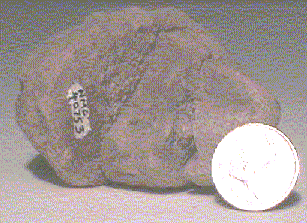
NMC 40753 *
When looking at the chemical makeup of coprolites, one will find a variety of compositions. The most common are calcium phosphate rich coprolites but carbonate,
iron-magnesium oxide, silicate, clay, and glauconite rich coprolites can be found
as well.
Different compositions come about through the process of permineralization.
This is the replacement or invasion of the original organic material by minerals,
which are usually carried in solution.

When analyzing coprolites, there are a few ways of doing so:
 X-ray Powder Diffraction (determines the relative positions of atoms in a crystal; Anomalous Dispersion can even tell the absolute configuration of the molecule)
X-ray Powder Diffraction (determines the relative positions of atoms in a crystal; Anomalous Dispersion can even tell the absolute configuration of the molecule) Infrared Spectroscopic analysis (IR) (the IR spectrometer compares two beams of IR radiation; one passes through a reference cell, containing only solvent and the other passes through a cell containing dissolved sample in the same solvent)
Infrared Spectroscopic analysis (IR) (the IR spectrometer compares two beams of IR radiation; one passes through a reference cell, containing only solvent and the other passes through a cell containing dissolved sample in the same solvent)  Gas Chromatography-Mass Spectroscopy (GC-MS) (used to separate organic molecules; the components of a mixture are forced to equilibrate between an immobile material (the stationary gas phase) and the moving material; the more time a component spends absorded, the more slowly it moves, and each component will move and therefore separate at different rates)
Gas Chromatography-Mass Spectroscopy (GC-MS) (used to separate organic molecules; the components of a mixture are forced to equilibrate between an immobile material (the stationary gas phase) and the moving material; the more time a component spends absorded, the more slowly it moves, and each component will move and therefore separate at different rates) Nuclear Magnetic Resonance (NMR) (gives an overall view of the structure of the organic molecule)
Nuclear Magnetic Resonance (NMR) (gives an overall view of the structure of the organic molecule)
| Back |  |
Next |